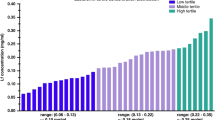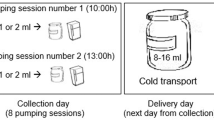Abstract
Background
Lactoferrin (Lf) is an important bioactive protein in human milk involved in diverse biological functions. Concentrations of milk Lf are tightly regulated during lactation. This study aims to investigate the longitudinal changes in human milk Lf concentrations during the first year postpartum and identify the factors associated with these changes.
Methods
This prospective cohort study recruited 160 dyads of healthy mothers and their full-term newborns in Wuqiang, Hebei province, China. Maternal and infant characteristics were collected using a structured questionnaire. Milk Lf concentrations were measured using an ELISA. A linear mixed model was employed to examine the longitudinal changes in Lf concentrations and identify associated factors.
Results
The mean milk Lf concentrations were 7.17 g/L, 4.02 g/L, 2.95 g/L, 2.19 g/L, and 2.43 g/L at 0–7 days, 30 days, 3 months, 6 months, and 12 months postpartum, respectively. The frequency of breastfeeding in the prior 24 h was negatively associated with Lf concentrations (P = 0.017). Prenatal mean corpuscular volume (MCV) status may influence the longitudinal changes in milk Lf (PMCV*time = 0.011).
Conclusions
Milk Lf concentrations decrease during the first 6 months and increase from 6 to 12 months, with these changes potentially associated with breastfeeding frequency and prenatal MCV status.
Impact
-
This study represents one of the largest cohort investigations of the dynamic changes and influencing factors of human milk Lf concentration in China.
-
The study investigated the relationship between maternal red blood cell indexes and milk Lf concentrations.
-
Milk Lf concentrations dynamically change throughout lactation, decreasing during the first 6 months and potentially increasing from 6 to 12 months.
-
The concentrations and longitudinal changes of milk Lf were impacted by the frequency of breastfeeding and maternal mean corpuscular volume.
This is a preview of subscription content, access via your institution
Access options
Subscribe to this journal
Receive 14 print issues and online access
$259.00 per year
only $18.50 per issue
Buy this article
- Purchase on SpringerLink
- Instant access to full article PDF
Prices may be subject to local taxes which are calculated during checkout

Similar content being viewed by others
Data availability
The datasets analyzed in this study are available from the corresponding author upon reasonable request.
References
Lönnerdal, B. & Iyer, S. Lactoferrin: molecular structure and biological function. Annu. Rev. Nutr. 15, 93–110 (1995).
Wang, B., Timilsena, Y. P., Blanch, E. & Adhikari, B. Lactoferrin: structure, function, denaturation and digestion. Crit. Rev. Food Sci. Nutr. 59, 580–596 (2019).
Rai, D. et al. Longitudinal changes in lactoferrin concentrations in human milk: a global systematic review. Crit. Rev. Food Sci. Nutr. 54, 1539–1547 (2014).
Gruden, Š & Poklar Ulrih, N. Diverse mechanisms of antimicrobial activities of lactoferrins, lactoferricins, and other lactoferrin-derived peptides. Int. J. Mol. Sci. 22, 11264 (2021).
Siqueiros-Cendón, T. et al. Immunomodulatory effects of lactoferrin. Acta Pharmacol. Sin. 35, 557–566 (2014).
Liao, Y., Jiang, R. & Lönnerdal, B. Biochemical and molecular impacts of lactoferrin on small intestinal growth and development during early life. Biochem. Cell Biol. 90, 476–484 (2012).
Ochoa, T. J., Pezo, A., Cruz, K., Chea-Woo, E. & Cleary, T. G. Clinical studies of lactoferrin in children. Biochem. Cell Biol. 90, 457–467 (2012).
Manzoni, P. Clinical benefits of lactoferrin for infants and children. J. Pediatr. 173, S43–S52 (2016).
Manzoni, P. Clinical studies of lactoferrin in neonates and infants: an update. Breastfeed. Med. 14, S25–S27 (2019).
Yin S. Human Milk Composition: Forms, Contents, Functions and Analytical Methods (Chemical Industry Press, Beijing, 2022).
Chen, J. et al. Three urban areas of China: a cohort study of maternal-infant factors and HM protein components. Food Funct. 13, 5202–5214 (2022).
Zhang, J. et al. Longitudinal changes in the concentration of major human milk proteins in the first six months of lactation and their effects on infant growth. Nutrients 13, 1476 (2021).
Garcia-Rodenas, C. L. et al. Temporal changes of major protein concentrations in preterm and term human milk. A prospective cohort study. Clin. Nutr. 38, 1844–1852 (2019).
Affolter, M. et al. Temporal changes of protein composition in breast milk of Chinese urban mothers and impact of caesarean section delivery. Nutrients 8, 504 (2016).
Tanaka, M. et al. Protein and immune component content of donor human milk in Japan: variation with gestational and postpartum age. Nutrients 15, 2278 (2023).
Villavicencio, A., Rueda, M. S., Turin, C. G. & Ochoa, T. J. Factors affecting lactoferrin concentration in human milk: how much do we know?. Biochem. Cell Biol. 95, 12–21 (2017).
Yang, Z. et al. Concentration of lactoferrin in human milk and its variation during lactation in different Chinese populations. Nutrients 10, 1235 (2018).
Wang, J. et al. Cohort profile: the Taicang and Wuqiang mother-child cohort study (TAWS) in China. BMJ Open 12, e060868 (2022).
LI, Y. et al. Comparison of assessment of food intakes by using 3 dietary survey methods. Chin. J. Preventive Med. 40, 273–280 (2006).
World Health Organization. Indicators for Assessing Infant and Young Child Feeding Practices-Part 2: Measurement (World Health Organization, 2010).
World Health Organization. Indicators for assessing infant and young child feeding practices-part 1: definitions (World Health Organization, 2007).
Yang, Y. & Ge, K. Encyclopedia of Nutrition Science (People’s Medical Publishing House, 2021).
Shang, H., Wang, L. & Shen, Z. National Guide to Clinical Laboratory Procedures (People’s Medical Publishing House, 2015).
Kulesza-Brończyk, B. et al. Factors affecting total protein and lactoferrin in human milk. Sci. Rep. 13, 22434 (2023).
Telang, S. Lactoferrin: a critical player in neonatal host defense. Nutrients 10, 1228 (2018).
Buccigrossi, V. et al. Lactoferrin induces concentration-dependent functional modulation of intestinal proliferation and differentiation. Pediatr. Res. 61, 410–414 (2007).
Cerami, C. Iron nutriture of the fetus, neonate, infant, and child. Ann. Nutr. Metab. 71, 8–14 (2017).
Hirai, Y. et al. Concentrations of lactoferrin and iron in human milk at different stages of lactation. J. Nutr. Sci. Vitaminol.36, 531–544 (1990).
Lönnerdal, B., Georgieff, M. K. & Hernell, O. Developmental physiology of iron absorption, homeostasis, and metabolism in the healthy term infant. J. Pediatr. 167, S8–S14 (2015).
Ren, Q. et al. Longitudinal changes in the bioactive proteins in human milk of the Chinese population: a systematic review. Food Sci. Nutr. 9, 25–35 (2020).
Czosnykowska-Łukacka, M., Orczyk-Pawiłowicz, M., Broers, B. & Królak-Olejnik, B. Lactoferrin in human milk of prolonged lactation. Nutrients 11, 2350 (2019).
Perrin, M. T., Fogleman, A. D., Newburg, D. S. & Allen, J. C. A longitudinal study of human milk composition in the second year postpartum: implications for human milk banking. Matern. Child Nutr. 13, e12239 (2017).
Trend, S. et al. Levels of innate immune factors in preterm and term mothers’ breast milk during the 1st month postpartum. Br. J. Nutr. 115, 1178–1193 (2016).
James, A. H. Iron deficiency anemia in pregnancy. Obstet. Gynecol. 138, 663–674 (2021).
Zavaleta, N. et al. Iron and lactoferrin in milk of anemic mothers given iron supplements. Nutr. Res. 15, 681–690 (1995).
Shashiraj, Faridi, M. M., Singh, O. & Rusia, U. Mother’s iron status, breastmilk iron and lactoferrin-are they related?. Eur. J. Clin. Nutr. 60, 903–908 (2006).
Fransson, G. B., Agarwal, K. N., Gebre-Medhin, M. & Hambraeus, L. Increased breast milk iron in severe maternal anemia: physiological “trapping” or leakage?. Acta Paediatr. Scand. 74, 290–291 (1985).
Acknowledgements
The authors appreciate Dr. Judith Hills for critical reading of the manuscript. This study was conducted as part of the Taicang and Wuqiang Mother-Child Cohort Study (TAWS) by the National Institute for Nutrition and Health. We are grateful to all the staff of the TAWS, whose hard work has made this study possible. We would like to thank all the study participants and their families for their voluntary participation and ongoing support for the TAWS.
Funding
This study was funded by the National Health Commission of China (2017–2021) and supported by Beijing Natural Science Foundation (S160002).
Author information
Authors and Affiliations
Contributions
Jianqiang Lai, Zhenyu Yang, and Yifan Duan designed the study. Xuyang Gu, Ying Li, and Ning Zhang were responsible for the acquisition of data and samples. Shan Jiang, Yuwen Zhang, Muxue Liu, and Yang Zhou were responsible for the experimental determination. Yang Zhou wrote the manuscript. Zhenyu Yang and Rulan Jiang reviewed the manuscript. All authors have read and approved the final version of the manuscript.
Corresponding author
Ethics declarations
Competing interests
The authors declare no competing interests.
Consent statement
Informed consent was obtained from all subjects involved in the study.
Additional information
Publisher’s note Springer Nature remains neutral with regard to jurisdictional claims in published maps and institutional affiliations.
Supplementary information
Rights and permissions
Springer Nature or its licensor (e.g. a society or other partner) holds exclusive rights to this article under a publishing agreement with the author(s) or other rightsholder(s); author self-archiving of the accepted manuscript version of this article is solely governed by the terms of such publishing agreement and applicable law.
About this article
Cite this article
Zhou, Y., Duan, Y., Jiang, S. et al. Longitudinal changes in human milk lactoferrin during the first year: a prospective cohort study. Pediatr Res (2025). https://doi.org/10.1038/s41390-025-04109-7
Received:
Revised:
Accepted:
Published:
DOI: https://doi.org/10.1038/s41390-025-04109-7



